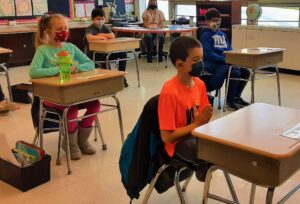 Once every six days, every single student at Todd Elementary School in Briarcliff Manor sits up a little more straight at his or her desk. Every six days, when Todd counselor Gillian O’Connell walks through the classroom door, every student knows: it is time for mindfulness. Ms. O’Connell walks in, rings a bell, and the students immediately close their eyes and practice mindfulness.
Once every six days, every single student at Todd Elementary School in Briarcliff Manor sits up a little more straight at his or her desk. Every six days, when Todd counselor Gillian O’Connell walks through the classroom door, every student knows: it is time for mindfulness. Ms. O’Connell walks in, rings a bell, and the students immediately close their eyes and practice mindfulness.
“They practice mindful breathing and pay attention to sounds,” said Ms. O’Connell, who recently wrapped up a lesson with Therese Verderosa’s third-grade class.
After the mindfulness, which typically lasts for one or two minutes, the students discussed the “weather.” In today’s lesson, some students shared that they felt “sunny” or “foggy.” A “tornado” was used to describe excitement.
Ms. O’Connell used the discussion about the weather to show the students that, like the weather, our emotions are always changing. In the lesson she also used the weather to describe changes in general.
“Sometimes we feel like a storm rolls in and we get angry, and then the sun comes out and we are happy. So, changes happen all the time inside of us. But there are also changes that happen outside and there are some changes that we cannot control,” she said to the students. She hopes students can remind themselves that even in stressful and uncertain times, such as now during the pandemic, the “sun” will still come out.
To help the students understand the concept of change, Ms. O’Connell described a big change for her family when they recently moved to Westchester. She described how the changes brought different emotions because her children were happy to move to a new house but were sad to leave their friends.
Ms. O’Connell next asked the students what changes they have experienced and the students shared their personal experiences. She pointed out that the emotions one might experience during a change, such as nervousness, are normal and it’s okay to feel them.
“I want the students to feel safe and comfortable sharing when I am in the class with them, to know they can talk about how they are feeling and that it’s okay to have those conversations,” Ms. O’Connell said. “The lessons are fifteen minutes long, so I want to maximize my time in those short snippets.”
Ms. O’Connell, who also sees students on an individual basis for counseling, has been creating these lessons on her own and modifies them for each grade level.
“I’ve been creative because there’s nothing out there that’s similar to what I am doing. I want the students to first of all understand what mindfulness is and the benefits of mindfulness,” she said. “I also want them to understand how our bodies react to our emotions as in the “fight or flight” response.”
Ms. O’Connell added that she modifies the lessons for each age group, using simpler terms for younger students. “I also talk about how our breathing can calm our nervous system,” she said.
During the lessons, Ms. O’Connell incorporates social skills.
“I try to have the students engage in conversations with one another. We did that when we recently had a lesson on gratitude,” she said. “They shared with each other things they were grateful for and practiced social skills.”
Ms. O’Connell takes a “Physician, heal thyself” approach and uses mindfulness for her own benefit as well.
“If I’m finishing a lesson for fifth graders, I have to completely change my mindset. The mindful moment in the beginning of the lesson is also for me – to settle in and be aware of my audience,” she said.






